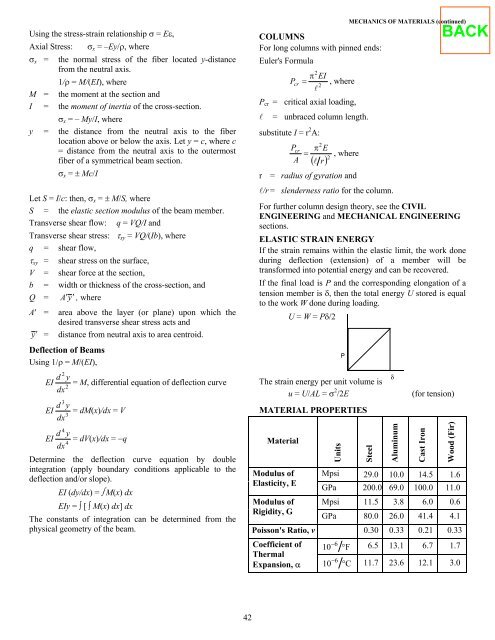fundamentals of engineering supplied-reference handbook - Ventech!
fundamentals of engineering supplied-reference handbook - Ventech!
fundamentals of engineering supplied-reference handbook - Ventech!
You also want an ePaper? Increase the reach of your titles
YUMPU automatically turns print PDFs into web optimized ePapers that Google loves.
Using the stress-strain relationship σ = Eε,<br />
Axial Stress: σx = –Ey/ρ, where<br />
σx = the normal stress <strong>of</strong> the fiber located y-distance<br />
from the neutral axis.<br />
1/ρ = M/(EI), where<br />
M = the moment at the section and<br />
I = the moment <strong>of</strong> inertia <strong>of</strong> the cross-section.<br />
σx = – My/I, where<br />
y = the distance from the neutral axis to the fiber<br />
location above or below the axis. Let y = c, where c<br />
= distance from the neutral axis to the outermost<br />
fiber <strong>of</strong> a symmetrical beam section.<br />
σx = ± Mc/I<br />
Let S = I/c: then, σx = ± M/S, where<br />
S = the elastic section modulus <strong>of</strong> the beam member.<br />
Transverse shear flow: q = VQ/I and<br />
Transverse shear stress: τxy = VQ/(Ib), where<br />
q = shear flow,<br />
τxy = shear stress on the surface,<br />
V = shear force at the section,<br />
b = width or thickness <strong>of</strong> the cross-section, and<br />
Q = A ′ y′<br />
, where<br />
A′ = area above the layer (or plane) upon which the<br />
desired transverse shear stress acts and<br />
y′ = distance from neutral axis to area centroid.<br />
Deflection <strong>of</strong> Beams<br />
Using 1/ρ = M/(EI),<br />
2<br />
d y<br />
EI = M, differential equation <strong>of</strong> deflection curve<br />
2<br />
dx<br />
3<br />
d y<br />
EI = dM(x)/dx = V<br />
3<br />
dx<br />
4<br />
d y<br />
EI = dV(x)/dx = −q<br />
4<br />
dx<br />
Determine the deflection curve equation by double<br />
integration (apply boundary conditions applicable to the<br />
deflection and/or slope).<br />
EI (dy/dx) = ∫ M(x) dx<br />
EIy = ∫ [ ∫ M(x) dx] dx<br />
The constants <strong>of</strong> integration can be determined from the<br />
physical geometry <strong>of</strong> the beam.<br />
42<br />
COLUMNS<br />
For long columns with pinned ends:<br />
Euler's Formula<br />
π EI<br />
Pcr = , where<br />
2<br />
�<br />
Pcr = critical axial loading,<br />
� = unbraced column length.<br />
substitute I = r 2 A:<br />
Pcr A<br />
2<br />
2<br />
π E<br />
= , where<br />
( ) 2<br />
� r<br />
r = radius <strong>of</strong> gyration and<br />
�/r = slenderness ratio for the column.<br />
MECHANICS OF MATERIALS (continued)<br />
For further column design theory, see the CIVIL<br />
ENGINEERING and MECHANICAL ENGINEERING<br />
sections.<br />
ELASTIC STRAIN ENERGY<br />
If the strain remains within the elastic limit, the work done<br />
during deflection (extension) <strong>of</strong> a member will be<br />
transformed into potential energy and can be recovered.<br />
If the final load is P and the corresponding elongation <strong>of</strong> a<br />
tension member is δ, then the total energy U stored is equal<br />
to the work W done during loading.<br />
U = W = Pδ/2<br />
The strain energy per unit volume is<br />
u = U/AL = σ 2 /2E (for tension)<br />
MATERIAL PROPERTIES<br />
Material<br />
Modulus <strong>of</strong><br />
Elasticity, E<br />
Modulus <strong>of</strong><br />
Rigidity, G<br />
Units<br />
Steel<br />
Aluminum<br />
Cast Iron<br />
Wood (Fir)<br />
Mpsi 29.0 10.0 14.5 1.6<br />
GPa 200.0 69.0 100.0 11.0<br />
Mpsi 11.5 3.8 6.0 0.6<br />
GPa 80.0 26.0 41.4 4.1<br />
Poisson's Ratio, v 0.30 0.33 0.21 0.33<br />
Coefficient <strong>of</strong><br />
Thermal<br />
Expansion, α<br />
−6<br />
10 ° F 6.5 13.1 6.7 1.7<br />
−6<br />
10 ° C 11.7 23.6 12.1 3.0
















